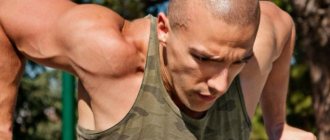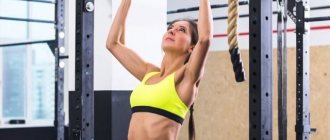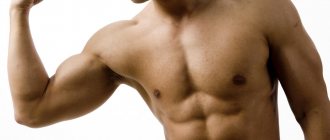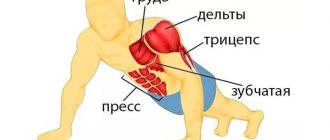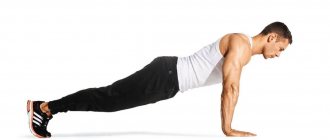Competent technique for performing the exercise and important nuances. How can you shift the load to the pectoral muscles or triceps. Every athlete (no matter whether he is a beginner or a professional in the world of sports) knows about this option for working out muscles, such as push-ups. With their help, it is possible to work the triceps, develop the anterior delta, work the pectoral muscle and stretch it efficiently. However, not everyone knows what the correct technique should be. The result is low efficiency of the training process and even injury.
Advantages
Why is it so useful to do push-ups on uneven bars? The following advantages are worth highlighting:
- Rapid development of the torso. During push-ups, the upper body is involved in the work - the lower pectoral muscles (when bending forward), triceps and shoulders receive the load. An interesting fact is that the lower part of the chest works weakly even when performing regular push-ups or a classic bench press.
- Working out the triceps and anterior deltoids. As practice shows, this exercise is an opportunity to qualitatively develop the shoulder girdle.
- Changing the load on different muscle groups depending on the angles of the body. So, when bending the torso forward, the lower pecs are worked out. If you do the exercise vertically, the triceps are more loaded.
How to pump up your chest on uneven bars | FaceNews.ua: Ukrainian news
Many people ask the question: is it possible to build muscles at home, or by working out on the sports field?
| How to pump up your chest on the uneven bars |
Many people ask the question: is it possible to build muscles at home, or by working out on the sports field? It is impossible to answer this question unequivocally, since everyone has their own concept of “pumping up muscles,” but we can say with great confidence that by working out at home or on the sports ground, it is possible to keep your muscles in good shape and have an athletic, toned body.
Let's talk today about chest training on parallel bars - a fairly affordable sports equipment that is present on every sports ground. You can also buy small parallel bars at a sports store and install them at home.
Of course, it is best to exercise in a gym, or rather a well-equipped gym, but not everyone has the time and opportunity for this. Therefore, parallel bars exercises can be considered as an additional training option.
Interesting: How to pump up your calves at home
Naturally, to get results from training, you need to carry it out, so get ready to work and train. Yuri Spasokukotsky, who made a whole video on this topic, will tell you how to do this and what are the aspects of training the chest on the uneven bars.
It is important!
We remind you that Yuri conducts training with everyone via the Internet, helping his clients build muscles, lose weight, create a diet for them, etc. All of Yuri's contact information is on his website.
Source: https://www.facenews.ua/articles/2014/250735/
General provisions
Despite its apparent simplicity, dips on parallel bars require knowledge of the rules and strict adherence to them. The following points are worth highlighting here:
- Place your wrists vertically and keep them level with the elbow joint. A normal grip is considered to be when the hands are slightly wider than the shoulders.
- Keep your elbows close to your body throughout the exercise. In the top position, they should be straightened completely only if you are focusing on the triceps. If you have sufficient flexibility, you should lower yourself to the limit of your joints.
- The shoulders should not move during the approach (no oscillatory movements). Otherwise, the risk of injury increases and efficiency decreases.
- Watch your spine - straighten it into a “string”. Thanks to this body position, the effectiveness of exercise increases.
- Try to tense your core (abs) muscles. The corset should be tight throughout the entire exercise. Thanks to this, it is possible to stabilize and hold the back in one position.
- It is forbidden to spread your legs (they must be pressed together or crossed). Tighten your hips and gluteal muscles, pull your toes back.
- Pay attention to your breathing. Air is released during ascent and gained as the body descends .
Training program
The chest push-up program will allow you to do everything correctly and in a certain quantity. You need such a program when training on your own. You will need to train three times a week.
- On Monday, try to do dips (4 sets of 15 reps).
- Tuesday is rest.
- Wednesday – push-ups with short stops (4 sets of 12 times).
- Thursday - rest.
- Friday – bent-over push-ups (4 sets of 15 reps).
And this should be done for a month. At the same time, try to change the types of push-ups, reduce the number of approaches and increase the number of times. Also remember to rest for about two to three minutes between sets. Plus, you now have a set of chest push-ups to make your workout easier.
Technology is the basis of success
Push-ups on parallel bars are performed using the following technique:
- to start the exercise from the bottom point . It is worth jumping onto the uneven bars and straightening your arms (this position is considered the starting position).
- Bend your torso forward (if you are working the lower pectoral muscles) and begin to lower yourself between the bars, bending your arms at the elbow joints. To activate your chest muscles, you should go as low as possible. If you “hang” at the midpoint and keep your body vertical, then the triceps receive the greatest load. At the end point, the chest should rise slightly above the projectile, and the hand should be at armpit level. You should not do deep descents from the very first workout (this is fraught with herbs). The body should be prepared gradually. In addition, you should not put additional weights on yourself until the muscles are sufficiently strengthened.
- At the bottom point, pause for 1-2 seconds , after which the torso rises to the top position. Please note that when working on the pecs, a slight extension of the elbows to the sides is mandatory. In addition, you should keep your body in an inclined position throughout the exercise. To switch the load to the triceps, keep your body vertical and press your elbow joints towards your body. It is worth considering here that the triceps are weaker than the chest, so dips on the uneven bars in this version should be performed in fewer repetitions or with less weight.
- The climb to the top point should be done slowly (in the absence of proper experience). You also need to lower yourself under control.
- Perform as many repetitions as your muscles can handle. When lifting is no longer possible, lower yourself and try again to rise on your hands. Even partial repetitions are effective and help stretch the chest. If the triceps get tired, you can move on to negative repetitions.
- If there is not enough experience in performing and the muscles are not able to even lift the body several times, then you should use a special exercise machine or place a chair under the parallel bars. In this case, the exercise is performed with the legs connected.
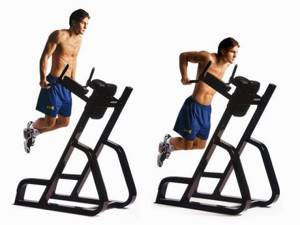
How can you replace dips?
In the absence of the opportunity to carry out exercises to strengthen the chest and triceps using the usual sports equipment, the question arises of what to replace push-ups on the uneven bars.
In order to answer this question, you need to remember what exactly the parallel bars pump, and replace the apparatus with several exercises to strengthen the triceps and chest:
- regular and reverse push-ups from a bench;
- French bench press lying and standing;
- extension of arms with a dumbbell from behind the head and in a tilted position.
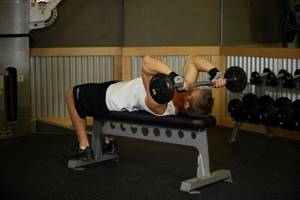
Bars are a great way to improve your fitness, health and mood. If you perform the exercises correctly and protect your body from unnecessary stress, you can achieve excellent results in a fairly short period of time.
Main mistakes
As you can see, push-ups on the uneven bars are a fairly simple exercise, the technique of which determines which muscle groups will be worked to a greater extent. But this does not prevent beginners and experienced athletes from making serious mistakes when performing. Among them:
- Errors in grip. It is often believed that a wide grip increases the load on the lower chest. But that's not true. Practice has shown that a medium grip is more effective when the hands are slightly wider than the shoulders . In this situation, the muscles are better loaded and less susceptible to injury.
- Incorrect inhalation and exhalation technique. Take in air before lowering to the bottom. The lungs should be filled for a full cycle of descent and 10-20% of ascent.
- Haste in execution. Another common mistake is doing push-ups in jerks. In such a situation, the muscles do not receive sufficient load for development. In addition, the risk of injury increases (especially if the joints are not warmed up). The process of lowering and raising should take an average of 2-2.5 seconds. After completely lowering, you should not immediately “jump” up - you should make a short delay. But this does not mean that the body is allowed to relax at the lowest point - the muscles must be tense.
- Insufficient warm-up. You cannot do the exercise if the body is not sufficiently warmed up. Initially, you should stretch your upper body. So, you should start with stretching, and then move on to regular push-ups and preparatory training on the uneven bars (at 0.5 full amplitude).

How to pump up your chest. Exercises on parallel bars
How to pump up your chest by doing exercises on the uneven bars. You will see the technique and find out which variations of dips on the uneven bars are the most effective.
I also give individual lessons via Skype, outline training programs and nutrition plans, looking at you and communicating with you: https://biceps.
ua/online-training The same thing, but in groups of 3-5 people (very affordable cost): https://biceps.com.ua/gruppa
How to pump up your breasts at home or outdoors? I often receive this question by mail, on social networks, or during conversations with friends, acquaintances and clients. This is understandable; in many courtyards there are sports grounds where people who want to get results from these workouts exercise.
Execution technique: 1. Starting position: take the initial stance on the uneven bars, while tilting your body forward, slouch and bring your shoulders together, bend your legs and move them slightly back. 2. As you inhale, lower your body down, but do not go too low so as not to injure your shoulder joints. 3.
Helpful advice!
As you exhale, lift your body down, without needing to fully straighten your elbows to relieve the stress on your elbow joints. 4. While moving up and down, you need to keep your body tilted forward and also spread your elbows to the sides. You always need to remember about your head, it cannot be lifted back, it must be tilted forward.
Interesting: How to pump up your elbow muscles
One of the most effective exercises in home training or training on the streets, which has a beneficial effect on the development of the pectoral muscles, is exercises on the uneven bars. Exactly exercises, since you can do push-ups on parallel bars in different ways, with different emphasis placed on different muscles.
In order to get the maximum result from push-ups on the uneven bars and the maximum impact on the pectoral muscles, I decided to make this video for you, in which I will tell you and show you how to train your pecs on the uneven bars. I am more than sure that this video will be useful for many due to the availability of this equipment and the ease of training.
Like, repost, leave comments and subscribe to my channel.
Source: https://biceps.com.ua/tehnika-vyipolneniya-uprazhneniy/trenirovka_doma_i_na_ulice/brusya
Results
In conclusion, it is worth highlighting a number of rules that the athlete must take into account:
- After strengthening the muscles and achieving maximum amplitude, you should move on to working with weights. Thanks to the additional weight, it is possible to reduce repetitions to 8-10 and accelerate muscle growth. The main thing is to be careful when lifting your body to the top position. Sharpness in performing exercises with weights is possible only after several months of training.
- When working, try to lower slowly (in 2-3 counts) and rise quickly.
- Slow lowering ensures chest stretching and microtrauma of muscle fibers, which subsequently promotes muscle growth.
How to properly pump your pectoral muscles on the uneven bars
The material was prepared by the site team with the support of our experts: athletes, coaches and nutrition specialists. Our team >>
Bars are a great way to build up your chest muscles. The ideal option would be sliding bars, the distance between which can be changed. If there are none, ordinary ones will do, we will adapt due to the position of the hands.
The main points when pumping up the chest on the uneven bars
Warm-up and stretching
The warm-up approach always comes first. And this is correct when your weight is not too high. Guys over 90 kg can easily damage their deltoids. Therefore, they need to warm up with push-ups on a bench. You need to perform 10-15 push-ups, starting at low speed and ending at a fast pace.
Before pumping your chest, you need to stretch. To do this, grab the parallel bars as if you were about to do an exercise. In this case, you slightly rest your feet on the floor or ground so as not to injure the ligaments with the weight of your body.
From this position we go down as far as possible and at this point we do several oscillatory movements. The sensation should be on the verge of pain, but not acute, but barely noticeable.
If your weight is light, warm up by doing 10-12 dips on the parallel bars, or more if your physical fitness allows you without compromising your main workout.
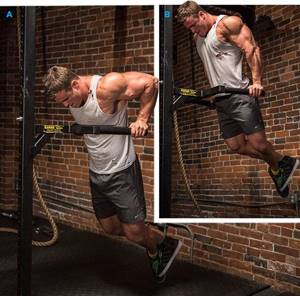
Before training, be sure to warm up well. The minimum is intense rotational movements of the arms in the shoulders, elbows and hands. The maximum is a five-minute jog in the fresh air, and then local warming up of the joints.
Weighting
To build up muscles on the uneven bars, you need a progressive load. You can exercise in the gym, on the street, and at home. There is a special belt in the hall on which you can hang pancakes. At home and on the street, a backpack with dumbbell plates neatly placed in it will suit you.
If you don't have dumbbells, plastic bottles from various drinks will do. Fill them with water - this way you can gain 10-15 kg of weight. Someone is putting weights in a backpack. We recommend using pancakes: they take up little space, and it is possible to conveniently dose the load by changing the number of pancakes in the backpack.
The only problem is how to carry this load to the training site. It's good if you're at home. We recommend purchasing a weight belt. So be prepared to carry the weight all the way to the site.
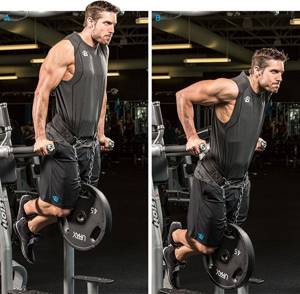
It is advisable that the backpack have additional fastening straps - then it will not painfully slap you on the back while walking and doing push-ups.
At first, a weight of 10–15 kg will be enough for you. Then the body will want more. With constant training you can reach up to 60 kg. Remember that it is convenient to carry no more than 20 kg with you. Heavier weights can cause damage to your pack and back.
Don’t experiment with how much weight you can do one push-up. This is dangerous for your collarbones. Let's pump up our strength, not test it just once.
Position of bars and arms
Don't forget that parallel bars also work your shoulders and triceps. To pump up your chest as much as possible, you need to:
- Lean forward slightly and slouch, contracting your pectoral muscle. The back becomes round.
- You can do “diving” movements and arch in a “boat” manner, then the middle part of the chest will work.
- With a more even execution, the lower chest works.
- We place our elbows to the sides, or move the bars further away from each other. Then the load will go to the pectoral muscles.
The further apart your elbows are, the less your arms work. Accordingly, the more the pectoral muscle is loaded. This is what we need.
Number of workouts per week, approaches, repetitions
To build muscle, you will need to achieve 4 sets of 6-8 reps with weights. And in the beginning, if you have not done push-ups before, you need to regularly perform this exercise 2-3 sets of 10-15 times. Each time we try to increase the number of repetitions.
For those who cannot do 10 repetitions in one approach, you need to work to the maximum. Do the first set as much as you can. Until failure. It's okay if you can't finish your last rep. Rest.
Do the second set to the max. Then the third. It is permissible to pump the pectoral muscle in this way 2 times a week with a break of 2-3 days.
Example: a person does push-ups on parallel bars without weights 20–25 times, depending on how he feels. He does the first approach 22 times, the second - 17, the third - 11. This is normal - the muscles get tired.
Rest between sets and workouts
Forget all the standard 1-1.5 minutes of rest between sets. In addition, this is most likely recommended by people actively taking pharmacological drugs. Their body recovers much faster, and they can easily complete the entire training plan with such a temporary regime and quickly pump up their body.
When you're working on strength and mass, you need to rest as much as your body requires. But no more than 5 minutes. Typically, athletes need 2-3 minutes between approaches.
While you are resting, there is no need to stand still. Walk back and forth, wave your arms, breathe deeply. It's important to rest, not cool down.
On the subject: Pumping up the upper pectoral muscles with push-ups
When you rest between workouts, be mindful of proper recovery. Without it, you won't be able to pump anything.
Technique
Now you know almost everything about push-ups. It's time to pump up your chest:
- Stand next to the bars. Sometimes the bars are high, sometimes low. It is important that you can get as low as possible on them without your feet touching the floor or ground.
- Firmly grasp the handles and take the starting position: slightly slouch, your legs can be pulled back, your head can be lowered a little. If you look strictly straight, the load will go to the triceps.
- Slowly lower yourself down to the maximum. The legs are crossed and the knees are slightly bent. If you start to sway too much, stop. Inertia does the thankless job of helping you do push-ups.
- You don't have to fully extend your arms. This way your arms are bent all the time. This takes the size of the load off the triceps, but at the same time increases the tension in them. To perform the approach normally you will need good endurance.
- Some bars are located at an angle to each other - this is very good for the chest. Stand on them so that your elbows point to the sides and not at each other.
- We do the required number of repetitions. Next, we hang the weight.
After the exercise, stretch. This will help build muscle faster.
Execution problems
Let's talk about the difficulties that may arise:
- Shoulder hurts. Forget about parallel bars for now. Try doing push-ups on the floor. The higher the bench you rest on, the less stress there will be on your shoulders and arms. Experiment. If it hurts anyway, you won’t be able to pump anything yet.
- My collarbone hurts. We recommend taking a break of 2–3 weeks. Then exercise without weights for a month. This pain occurs when your trapezius is not ready to support the body with weights in such a hanging position.
- Elbows hurt. Use warming ointment (just a little, less than what is written in the instructions) and wrap your elbows with an elastic bandage. If it doesn’t help, you shouldn’t do dips yet.
Source

